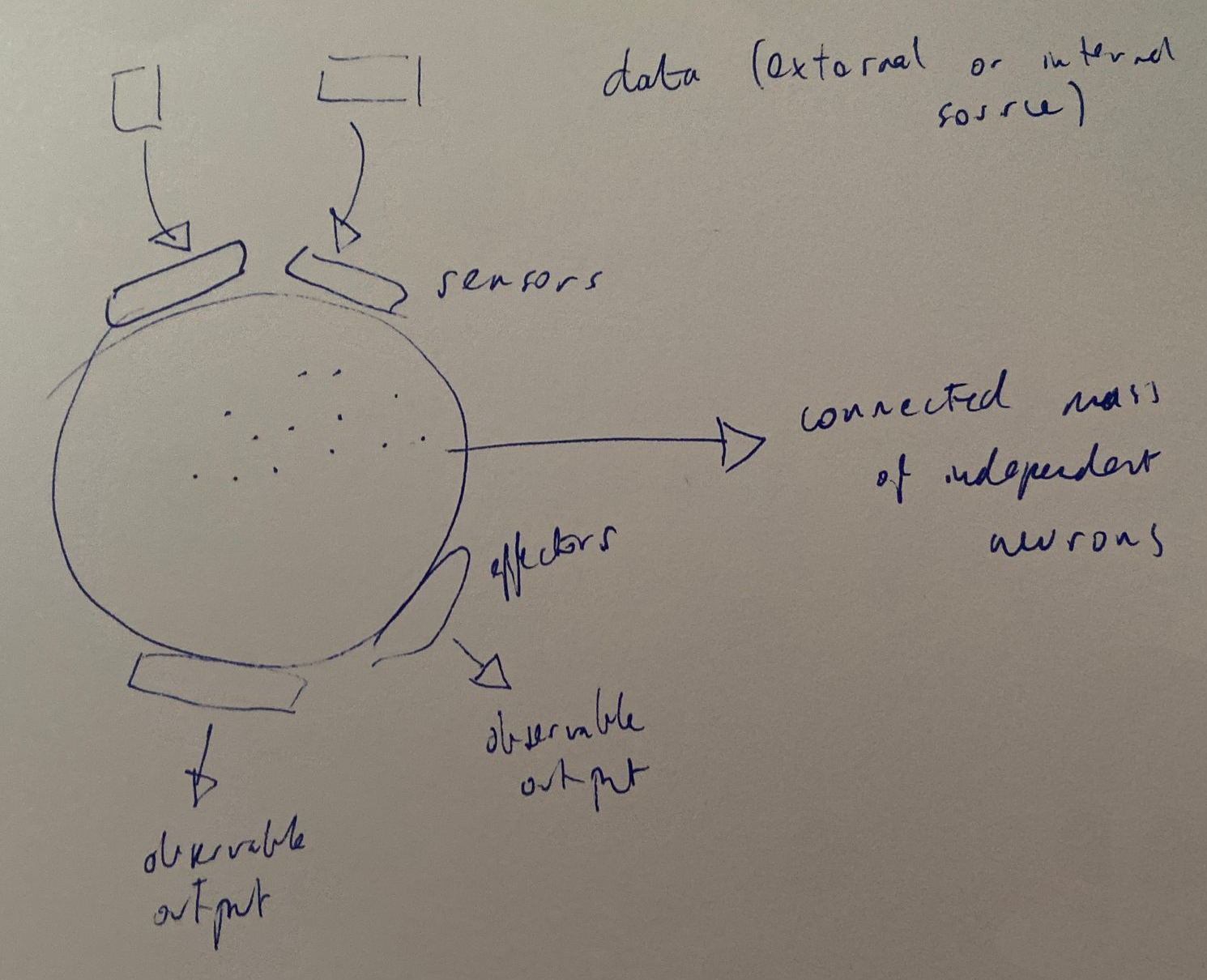Brain Model

Legend
Unanswered question/issue
Probably V2 model
Architecture
Neurons, of 3 different kinds, organised in a brain mass:
- Afferent (sensory) Neurons - special input, output to neurons
- Interneurons - neurons to neurons
- Efferent (effector) Neurons - input from neurons, special output
The brain is conceived as a structure that contains the neurons. However, this may not be a domain object, but just observable behaviour/properties of the amalgam. (Derived) attributes are:
- Afferent surface(s): receptor function(s)
- Efferent surface(s): effector function(s)
- Overall size, linkedness, other network characteristics
- Structure and location of neurons
- Neurons that share function should be co-located. In a good system, this would be hardware realities (rather than virtualised).
Neurogenesis? Does this require some active concept/object outside of neurons? Or, neurons could (coordinate to?) create neighbours under some conditions? Not how it works in the brain, but maybe just as good (or better).
Neurons
Behaviour
- Receive special input (afferent)
- Receive neuron signal (interneuron, efferent)
- Transform neuron signal input
- Change input transformer function
- Trigger outward signal based on (aggregated) input
- Change trigger threshold function (only if this doesn’t end up being global, eg. because we want to increase our capacity for internal state)
- Send neuron signal (afferent, interneuron)
- Transform neuron signal output
- Change output transformer function
- Send special output (efferent)
- Add inward connection (interneuron, efferent)
- Prune inward connection (interneuron, efferent)
- Add outward connection (afferent, interneuron)
- Prune outward connection (afferent, interneuron)
- Apoptosis (death)
- Genesis (birth)
Attributes
Individual
- Location of neuron within the system
- Distance from (connected and unconnected) neighbours
- Inward connected neighbours
- Outward connected neighbours
- Input transformer function
- By inward connected neighbour
- Or group
- Output transformer function
- By outward connected neighbour
- Or group
Global
- Initial values/functions, and ranges/limits for:
- Location
- Inward neighbours
- number
- selection
- Outward neighbours
- number
- selection
- Input transformer function
- By inward neighbour
- Or group
- Output transformer function
- By outward neighbour
- Or group
- Trigger threshold function
- Absolute refractory function
- Post refractory period function
- Signal decay to baseline function
- Trigger for adding an inward connection
- Trigger for pruning an inward connection
- Trigger for adding an outward connection
- Trigger for pruning an outward connection
- Trigger for apoptosis
- Trigger for genesis
Processes
Are there different processes? Why would there be.
Train
- “unlabelled”; just form structure
- “labelled”; associative - providing input of type A (eg. visual) and type(s) B(-Z) (eg. conceptual) at the same time to guide associative structure
Interact
- seeking some specific output - probably the same as the unlabelled training action, given the assumption that you can infer output on the effector you’re interested in
Questions
In the absence of input, what should happen?
After some time, baseline behaviour: eg nothing
Insight into internal state? Monitoring?
This is a combination of:
- effector function(s) for higher level information (”what are you thinking about”)
- regular software monitoring
Intentional structure?
For example, a communication channel in the middle of the brain, like our white matter.
Or, to represent our concept of instincts (eg. every neurotypical brain recognises human faces from birth easily)
Do we need more internal state?
For example for short/long term memory (though digital storage with access would probably be eventually a nice advantage), attention…
Speeds/rates, framerate in general
Think about this